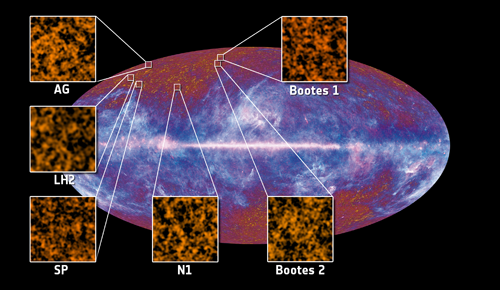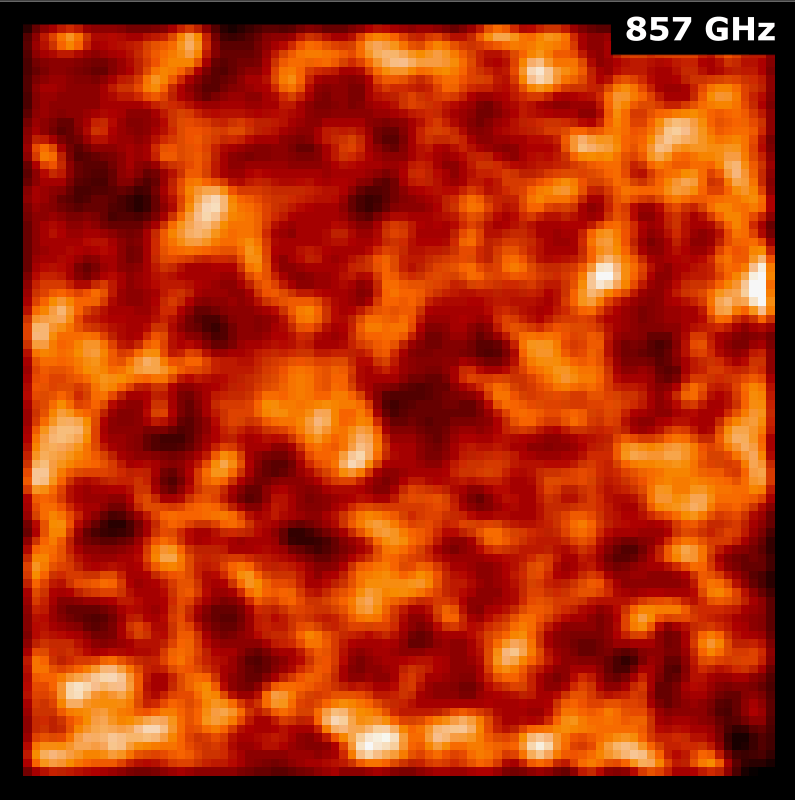| Basic Information | |
| What is this? | The Cosmic Infrared Background, the emission from dust galaxies in the early Universe |
| Where is it in the sky? | Planck observes it in areas where our own Galaxy is not shining brightly |
| How big is it? | If pervades the entire Universe |
| How far away is it? | The most distant galaxies are seen when the Universe was only around 2 billion years old |
| What do the colours represent? | Brighter colours represent brighter emission, which means more densely clustered galaxies |
Downloads
While observing the Cosmic Microwave Background, Planck has also measured another important diffuse radiation: the Cosmic Infrared Background (CIB). This is emitted by galaxies in the early Universe, but which are so far away that they blur together when seen by Planck. It’s not a completely uniform blur though, and there are warmer and colder regions, corresponding to variations in the grouping of galaxies in the early Universe.
The CIB, which is about 50 times weaker than the CMB, is produced by the dust within the distant galaxies, which is warmed by the stars forming within. The light from these galaxies has been travelling for billions of years, and some of the galaxies are seen as they were when the Universe was only around 2 billion years old – more than 11 billion years ago. While they can’t be studied individually, the CIB represents an exceptional tool to study these objects and to trace their overall distribution.

“Thanks to Planck’s extensive spectral coverage, we have been able to detect the CIB signal and its fluctuations with great accuracy in the submillimetre range, down to frequencies where it has never been seen before,” comments Jean-Loup Puget from the Institut d’Astrophysique Spatiale in Orsay, France, who is principal investigator of the High Frequency Instrument (HFI) on board Planck, the instrument used in this study. “The quality of the data collected by Planck thus far is so good that, at the highest available frequency, it is possible to spot the fluctuations even by eye,” he adds.
The CIB has been seen before at sub-millimetre wavelengths, and is detected at Planck’s highest frequency channels. Now, the CIB has been seen at the lowest frequency (longest wavelength) so far, by Planck’s 217 GHz detectors. These longer wavelengths tend to see objects earlier in the Universe. Joanna Dunkley, of the University of Oxford, said “Planck’s measurements of the Cosmic Infrared Background are shedding new light on when and where ancient stars formed in the early universe”.
“This project focussing on the CIB is a great example of the cooperation between researchers studying galaxies and those interested in the CMB, since the methods and expertise have been shared between the two groups,” adds Olivier Doré, co-leader of this study, from the Jet Propulsion Laboratory/Caltech in Pasadena, USA. This is a notable advantage of the large Planck Collaboration, allowing for a fruitful synergy between many astrophysical communities.
In order to perform these early measurements of the CIB, astronomers from the Planck Collaboration employed only about 2.5 per cent of the entire sky, focussing on a handful of fields located at high galactic latitude, where the foreground contamination due to the Milky Way’s diffuse emission is less dramatic. The remarkable results achieved thus far are an exciting hint at the even more precise measurements which will be possible once the study is extended to the full-sky data. “One of the unique features of Planck is the ability to reveal the fluctuations in the CIB on very large scales, an invaluable source of information in the quest to unravel the complete history of star and structure formation in the Universe,” concludes Jan Tauber, Planck Project Scientist at ESA.
This is one of a number of early Planck results based on scientific papers published in early 2011.

